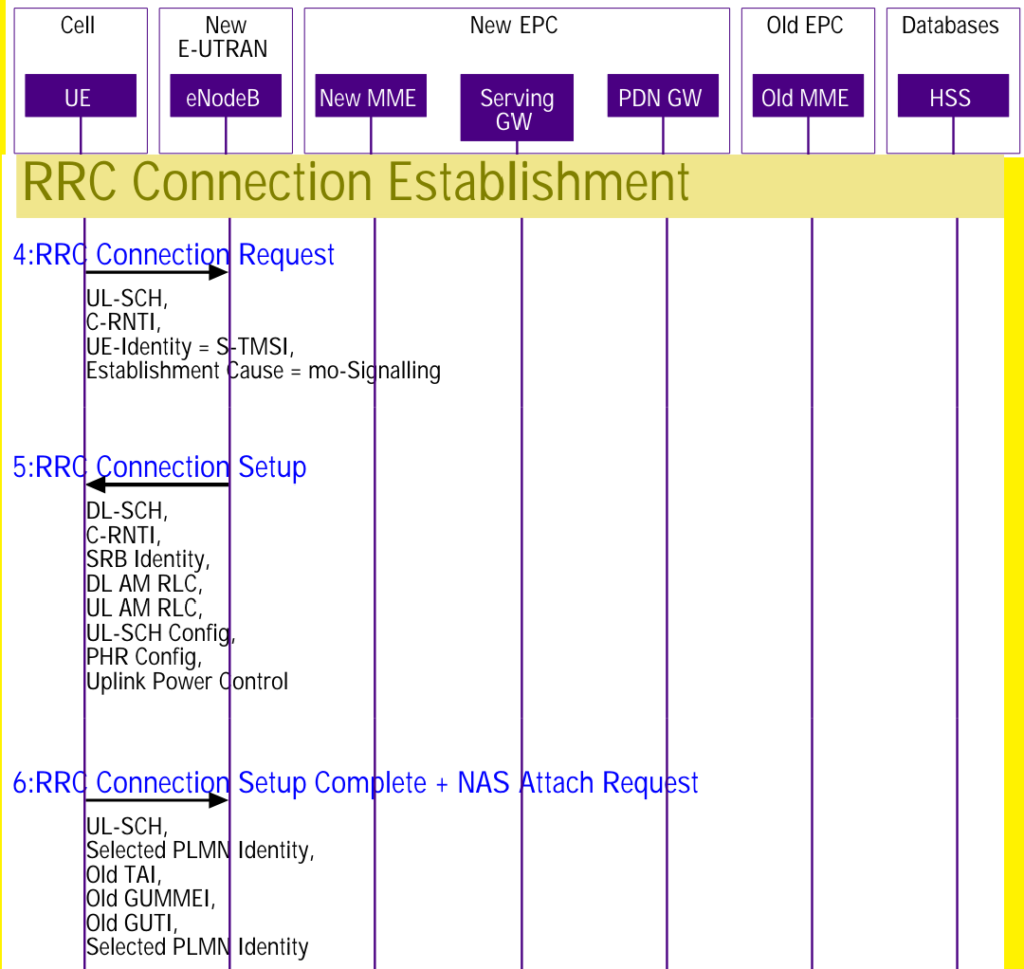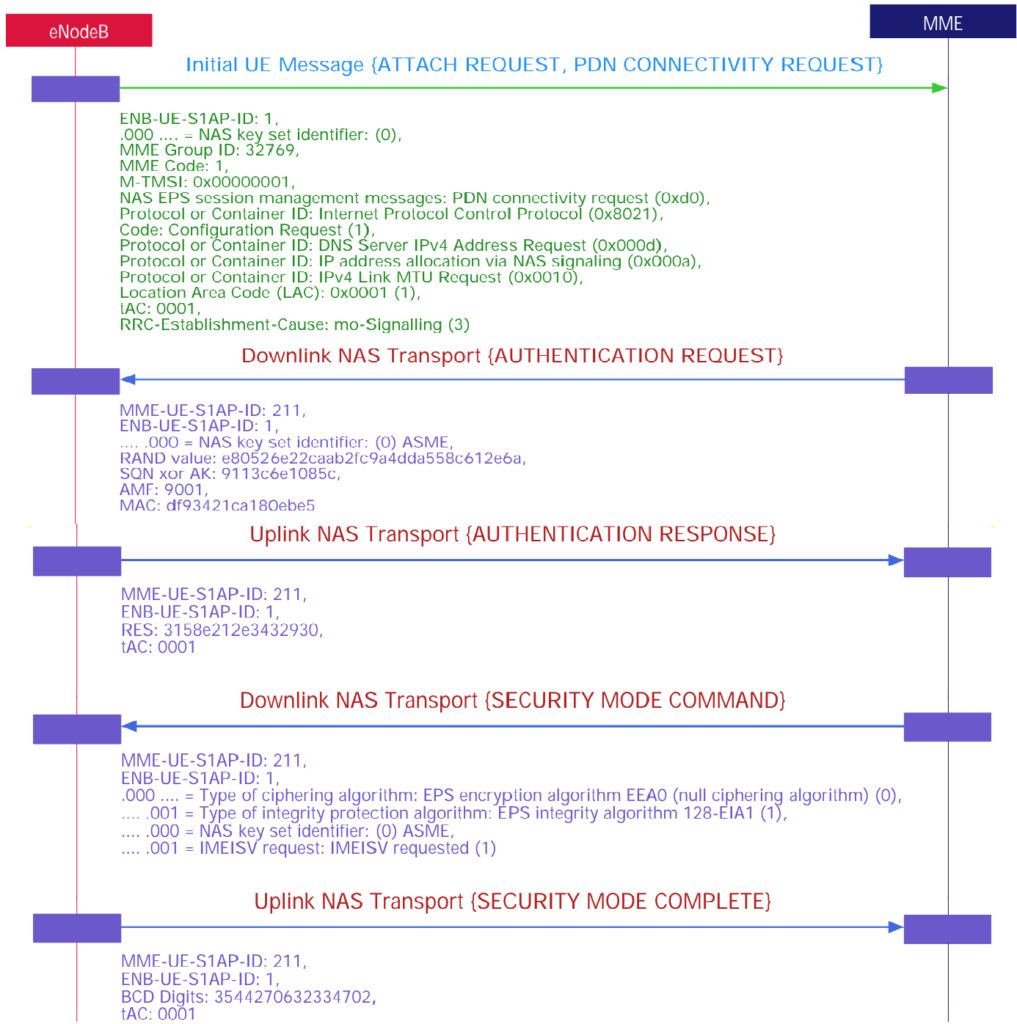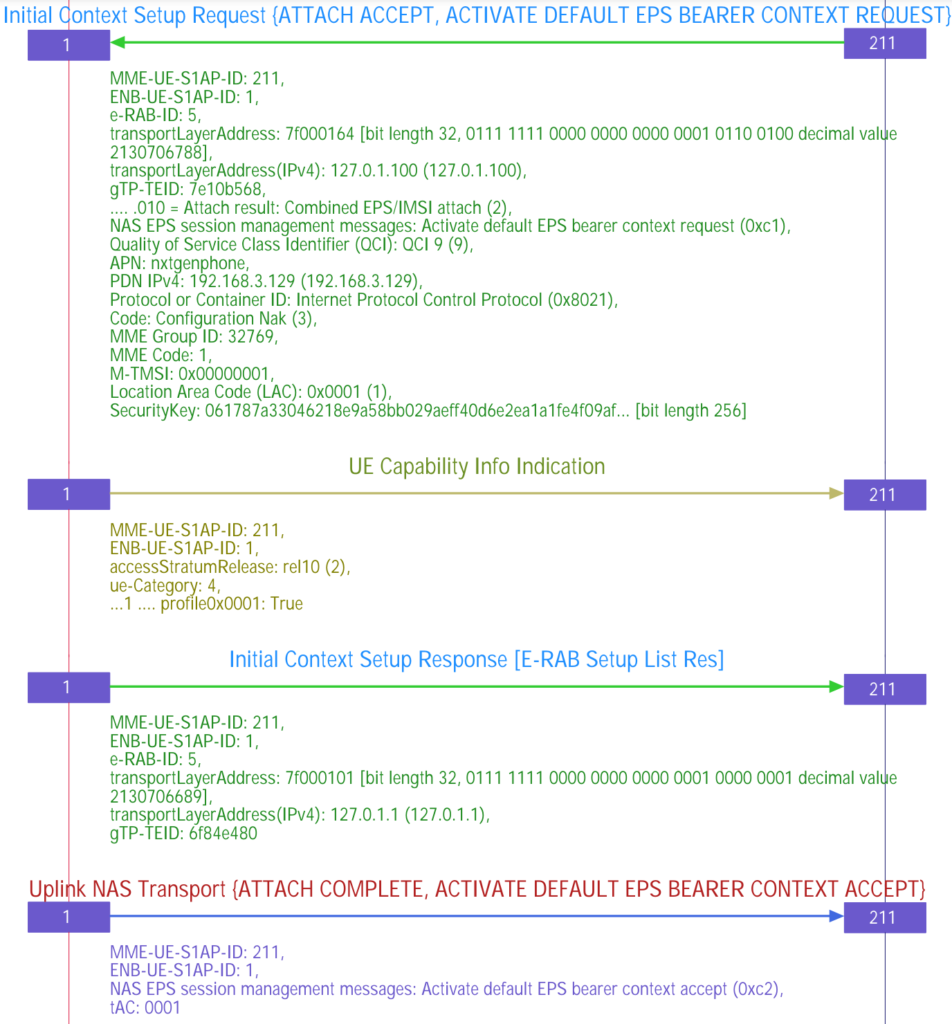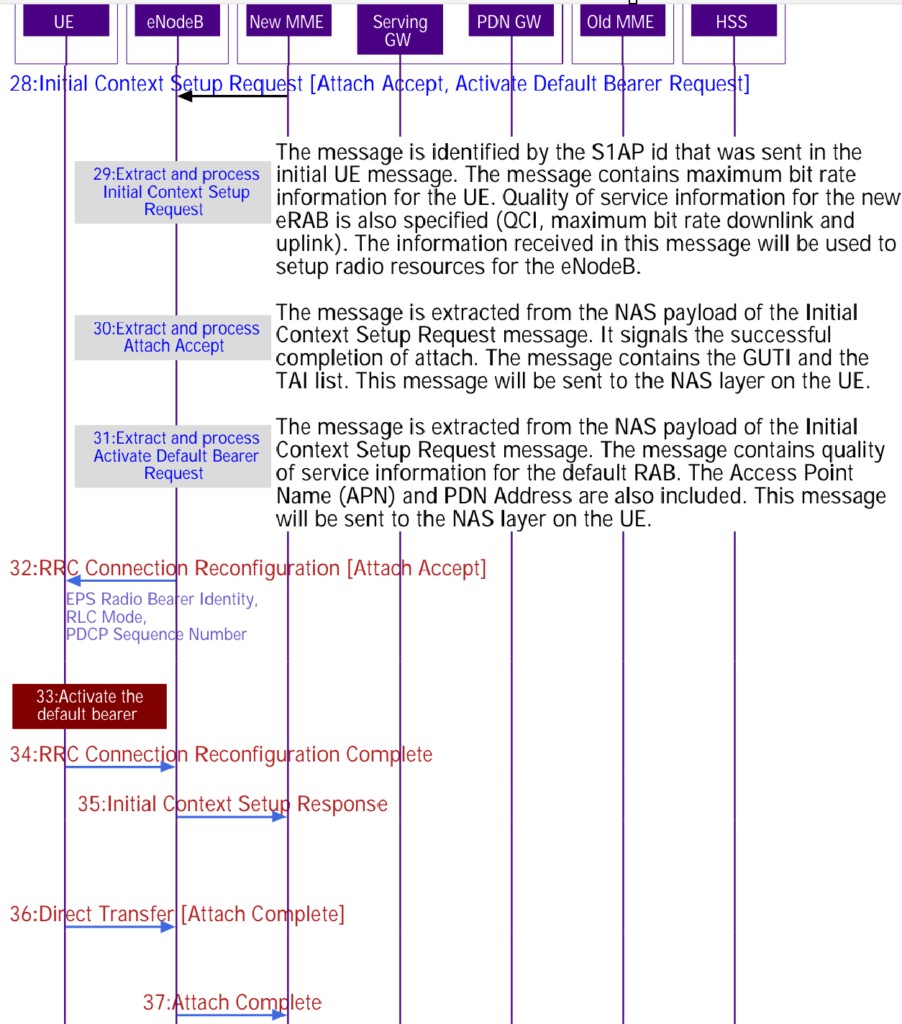This article is about LTE attach procedure signalling. Below picture show complete signalling overview of attach.

I have divided LTE attach procedure signalling into different sections and explained one by one.
1. RRC Connection Establishment.

The Radio Resource Control (RRC) layer is responsible for establishing a connection between the User Equipment (UE) and the eNodeB (evolved NodeB). The RRC connection establishment procedure begins with the UE initiating a random access request by sending a preamble. This preamble allows the eNodeB to recognize the UE’s request to access the network. Once the eNodeB detects this request, it responds with a Random Access Response message. This response assigns a temporary identifier to the UE, known as the Temporary Cell-Radio Network Temporary Identifier (C-RNTI). Additionally, the response message includes timing advance information and an uplink grant for the UE to send the subsequent RRC Connection Request message.
Using the allocated resources on the Uplink Shared Channel (UL-SCH), the UE sends an RRC Connection Request message. This message contains the UE identity, typically the S-TMSI (SAI-Temporary Mobile Subscriber Identity), which includes the MMEC (Mobility Management Entity Code) and M-TMSI (Temporary Mobile Subscriber Identity). The message also specifies the establishment cause for the RRC connection, indicating the reason for the request, such as a mobile-originated call, mobile-terminated call, or emergency call. This detailed information allows the network to understand the context and priority of the connection request.
In response, the eNodeB sends an RRC Connection Setup message on the Downlink Shared Channel (DL-SCH). This message establishes the Signaling Radio Bearer (SRB) in Acknowledged mode, ensuring reliable communication between the UE and the eNodeB. The RRC Connection Setup message includes configuration parameters for the uplink Radio Link Control (RLC), UL-SCH, Power Head Room (PHR), and Uplink Power Control. These configurations are crucial for maintaining the quality and efficiency of the connection, adjusting parameters to optimize the uplink performance based on current conditions.
S1AP View of LTE Attach & EPS Bearer Setup
2. Authentication & Security Signaling (NAS Encryption).

When a User Equipment (UE) initiates a connection to the network, it sends an initial message containing an Attach Request and a PDN Connectivity Request. This message includes UE-specific information such as the Public Land Mobile Network (PLMN) and the Tracking Area. Additionally, the message conveys details about the requested services. As part of this process, the UE also sends an ESM (Evolved Packet System Mobility Management) information transfer flag in the PDN Connectivity Request message to indicate that the Access Point Name (APN) will be sent only after the encryption has been established, ensuring the security of sensitive information.
The Mobility Management Entity (MME) then sends an Authentication Request to the UE. This message includes the Random number (RAND) and the Authentication Token (AUTN), which are used to verify the identity of the UE. The message also contains a Key Selection Identifier (KSI-ASME) that helps in selecting the appropriate security keys. This initial Authentication Request is sent in an unencrypted, clear format.
In response, the UE computes a response value (RES) using the RAND and AUTN, and sends this RES value back to the MME. This step helps in confirming the authenticity of the UE and ensures that it is authorized to access the network.
Following successful authentication, the MME initiates the NAS (Non-Access Stratum) security procedure. This involves selecting and configuring encryption and integrity protection algorithms to secure the communication. The MME includes these algorithm details and the Key Selection Identifier (KSI-ASME) in a message sent to the UE. This step is crucial for establishing a secure communication channel between the UE and the network.
The UE responds to the MME with a message that is now NAS ciphering and integrity protection using the agreed-upon algorithms. This message confirms the security settings and ensures that subsequent communications are protected from tampering.
3. Default EPS Bearer Establishment.

The Default EPS Bearer Establishment process involves setting up the data service and assigning an IP address to the UE, as well as configuring Quality of Service (QoS) parameters. This procedure ensures that the UE can effectively communicate with the network and receive the necessary data services.
MME Response: The Mobility Management Entity (MME) initiates the process by sending a combined message to the UE. This message includes the Attach Accept and the Default Bearer establishment request. The bearer request contains essential information such as QoS parameters, Access Point Name (APN), and Packet Data Network (PDN) details. This step establishes the initial data connection and assigns an IP address to the UE, ensuring it can access the network services.
UE Capability Information: The UE responds by sending a detailed capability information message to the network. This message provides comprehensive details about the hardware and software features of the UE. By sharing this information, the UE ensures that the network is aware of its capabilities, which can be used to optimize the network’s performance and service delivery.
eNodeB Initial Context Setup: The eNodeB (Evolved Node B) responds to the Initial Context Setup Request from the MME. This response includes details about the Radio Access Bearer (RAB) establishment, specifically indicating the eRAB ID (eRAB id 5). The RAB establishment is crucial for setting up the data paths and ensuring that the data services are properly configured.
Attach and Bearer Acceptance: The eNodeB then transports the attach acceptance and the default EPS Bearer acceptance messages back to the UE. This step confirms that the attach procedure and the default bearer setup have been successfully completed. The UE is now connected to the network with an assigned IP address and the configured QoS parameters, ready to send and receive data.
4. LTE Attach Complete.

- MME Response to eNodeB: The MME sends a message to the eNodeB containing three parts:
- SIAP Initial Context Setup Request.
- NAS Attach Accept.
- Activate Default Bearer Request.
- Message Identification: This message uses the S1AP ID from the initial UE message. It includes details about the maximum bit rate and quality of service (QoS) for the new eRAB, which the eNodeB will use to set up radio resources.
- Attach Completion Signal: Extracted from the NAS payload, this part of the message confirms successful attach. It contains the GUTI (Globally Unique Temporary Identifier) and TAI (Tracking Area Identity) list and will be sent to the NAS layer on the UE.
- QoS Information for Default RAB: Also extracted from the NAS payload, this message includes QoS details for the default RAB, the Access Point Name (APN), and the PDN (Packet Data Network) address, which will be sent to the NAS layer on the UE.
- RRC Connection Reconfiguration: This message is sent to activate the default radio bearer and includes the Attach Accept message as NAS payload. It is used to establish signaling radio bearer (SRB) 2 and data radio bearer (DRB) 1.
- UE Response to eNodeB: The UE sends a reply back to the eNodeB.
- Initial Context Response to MME: The eNodeB sends an Initial Context Response message to the MME. This includes the TEID (Tunnel Endpoint Identifier) and the address of the eNodeB for downlink traffic on the S1_U interface.
- Attach Complete Message: The UE sends a Direct Transfer message to the eNodeB, which includes the Attach Complete message with EPS Bearer Identity, NAS sequence number, and NAS-MAC (Message Authentication Code).
These steps ensure that the UE is successfully attached to the network, with appropriate QoS settings, and ready for data services.
LTE Attach: Signaling over the Uu and S1 Interfaces.
Signaling over the Uu interface.

Signaling over the S1 interface.
